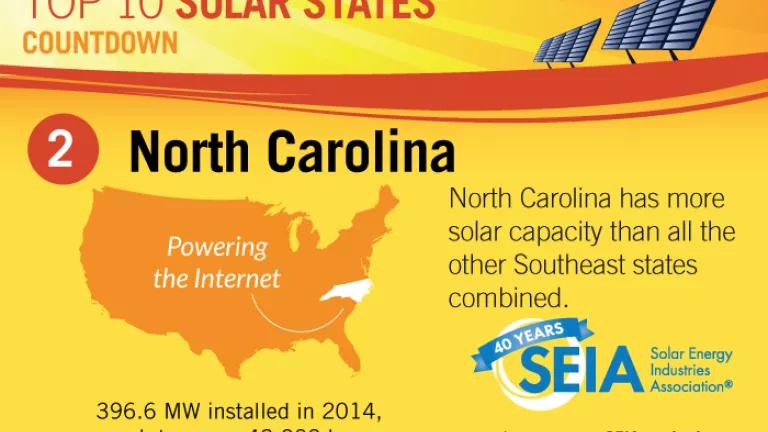
As a North Carolinian, I can tell you it's pretty darned amazing that, last year, our state was number 2 in the nation in installed solar capacity. And number 4 in the first quarter of 2015, despite what can only be described as some really crappy (and construction-slowing) winter weather.
That's the case, even though, only a few years ago, our state was a serious dark horse in the race for solar greatness. Now, here in North Carolina, clean power technology is growing faster than almost anywhere in the country. That's made us Tar Heels an inspiration to other states across the Southeast. And contributed significantly to our state's economy, with 5,600 solar jobs in 2014 (up by a walloping 2,500 jobs from 2013, when solar jobs topped 3,100 jobs). There are 177 solar businesses reaching almost every corner of the state. And last year, $652 million in private funds were invested in solar installations here, much of it in rural counties. (Between 2009 and 2013, that clean-energy private-investment number is an eye-popping $2.6 billion.)
While the plummeting cost of solar nationwide is helping to install a dizzying amount of the pollution-free power technology across the U.S., that fact doesn't explain why North Carolina has risen so fast in the state ranks. In 2006, we were 19th in the nation in installed capacity. Last year, we were an incredibly impressive second. (Got that? We were ahead of some blisteringly bright states like Nevada and Arizona.) Now, we're 4th in total installed capacity, despite our slow start. The more than 1,000 megawatts of solar we have online here is enough to power 110,000 homes. And the amount of carbon pollution those panels prevent is the equivalent of taking 200,000 cars off North Carolina roads.
Did I mention that an additional 6,000 megawatts of utility-scale solar projects are slated to be developed in our state by the end of 2016?
"Smart, effective public policies such as the state's renewable portfolio standards," are key drivers, explains Ken Johnson, the Solar Energy Industries Association's vice-president of communications. (SEIA is a solar industry trade group.) North Carolina is currently the only state in the Southeast with a binding clean energy target: 12.5 percent of its electricity must be supplied by clean sources by 2021, according to the state's Renewable Energy and Energy-Efficiency Portfolio Standard (REPS). (Right now, we're on track to meet the 2015 target of 6 percent.) Add to that standard "federal and state investment tax credits," Johnson says, "and solar in North Carolina continues to boom."
Now, all this incredible progress is threatened, by fossil-fuel-backed state legislators who want to first cap and then, in 2018, discontinue the REPS.
They claim the law skews the free market and cost consumers money. But they're wrong on both counts. To begin with, North Carolina, with its monopoly utilities, has nothing approaching a free market for electricity. And the REPS has already saved North Carolinians $162 million on their energy bills and is projected to save a total of $651 million by 2029, a study released this winter shows. Opponents are also putting their thumbs on the energy-costs scale. The price they cite for electricity doesn't include the high health and environmental costs that dirty, fossil-fuel power imposes on us all. Like the toxic coal ash spill into the Dan River just over a year ago. Those health costs alone come in at 17-27 cents a kilowatt hour, which is equivalent to $1,000 to $1,600 per American per year, according to one Harvard University study.
Clean energy advocates aren't the only ones who think this repeal effort is an incredibly bad idea. Bank of America's former Chairman and CEO Hugh McColl Jr., and Duke Energy's former Chairman and CEO Jim Rogers have both penned op-eds in support of the REPS. McColl noted that "[s]tates that encourage development of growth industries gain major advantages in our competitive global economy." Rogers observed how solar "generates far more economic value over its lifetime than the subsidies it receives." They've been joined by more than 50 state religious leaders, who took out a full-page ad in the News and Observer that read, "We've seen the light on solar power." Apple, Google and Facebook wrote to leaders of the state Senate and House of Representatives: "We believe the REPS should be maintained because our collective experience shows that programs like the REPS can actually reduce the overall cost of energy to ratepayers.... Any change should therefore consider not just protecting, but expanding these benefits...."
Clearly, the anti-REPS legislators are motivated more by ideology (and campaign donations) than facts.
North Carolina shouldn't squander our opportunity to lead the Southeast and the rest of the nation in solar capacity, solar jobs, energy-cost savings, and carbon-pollution reductions. The REPS helps stay on that path.
On clean energy, now is the moment to move forward, not back.




